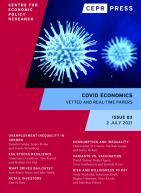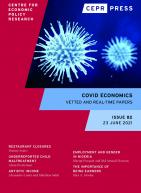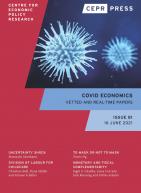
New binary classification tests are often evaluated relative to a pre-established test. For example, rapid Antigen tests for the detection of SARS-CoV-2 are assessed relative to more established PCR tests. In this paper, I argue that the new test can be described as producing ambiguous information when the pre-established is imperfect. This allows for a phenomenon called dilation—an extreme form of non-informativeness. As an example, I present hypothetical test data satisfying the WHO's minimum quality requirement for rapid Antigen tests which leads to dilation. The ambiguity in the information arises from a missing data problem due to imperfection of the established test: the joint distribution of true infection and test results is not observed. Using results from Copula theory, I construct the (usually non-singleton) set of all these possible joint distributions, which allows me to assess the new test's informativeness. This analysis leads to a simple sufficient condition to make sure that a new test is not a dilation. I illustrate my approach with applications to data from three COVID-19 related tests. Two rapid Antigen tests satisfy my sufficient condition easily and are therefore informative. However, less accurate procedures, like chest CT scans, may exhibit dilation.
Citation
Ziegler, G (2021), ‘Binary Classification Tests, Imperfect Standards, and Ambiguous Information‘, COVID Economics 66, CEPR Press, Paris & London. https://cepr.org/publications/covid-economics-issue-66#392514_392942_390708
Using high-frequency proxies for economic activity over a large sample of countries, we show that the economic crisis during the first seven months of the COVID-19 pandemic was only partly due to government lockdowns. Economic activity also contracted severely because of voluntary social distancing in response to higher infections. Furthermore, we show that lockdowns substantially reduced COVID-19 cases, especially if they were introduced early in a country's epidemic. This implies that, despite involving short-term economic costs, lockdowns may pave the way to a faster recovery by containing the spread of the virus and reducing voluntary social distancing. Finally, we document that lockdowns entail decreasing marginal economic costs but increasing marginal benefits in reducing infections. This suggests that tight short-lived lockdowns are preferable to mild prolonged measures.
Citation
Grigoli, F, D Sandri and F Caselli (2021), ‘Protecting Lives and Livelihoods with Early and Tight Lockdowns‘, COVID Economics 66, CEPR Press, Paris & London. https://cepr.org/publications/covid-economics-issue-66#392514_392942_391063
The Covid-19 pandemic has triggered unprecedented levels of disruption and stress for workers. Still, little is relatively known about the state of mind of the workforce, even if its well-being is increasingly recognized as a driver of productivity. This paper encompasses multiple forms of stress - health, economic, social, and psychological – faced by the workforce, and demonstrates that not only have workers been facing large levels of stress during the Covid-19 pandemic beyond health issues, but that stress is not uniformly distributed among workers. While it is known that Covid-19 has been building a divide between remote and on-site workers, we uncover a much larger divide than the ones induced by work location alone, with the divide being due to different perceptions of mix and level of worries. Human resources practices may have to be much more personalized and include all forms of stress to diagnose the level of workers’ state of fragility if they wish to create a much more resilient and productive workforce.
Citation
Żyszkiewicz, M, D Reykowska, M Cincera, R Ohme and J Bughin (2021), ‘The great employee divide: Clustering employee «well-being» challenge during Covid-19‘, COVID Economics 66, CEPR Press, Paris & London. https://cepr.org/publications/covid-economics-issue-66#392514_392942_390709
Evidence is provided as to how government containment and closure policies in response to the COVID-19 pandemic in affected firm-level employment and hours worked and the differential employment impacts of such policies between men and women. The analysis uses data from the World Bank’s Enterprise Analysis Unit survey of business enterprises owners and top managers located in 20 emerging nations about the impact that COVID-19 had on their business operations. Several principal conclusions are drawn from the analysis. First, containment and closure policies, viewed as a whole, impacted negatively permanent jobs and total hours worked at the firm level, but not temporary employment. Second, school and workplace closing policies increased the likelihood that firms reduced permanent employment, but the impact did not fall disproportionately on women. Third, public transport closings negatively impacted the employment prospects of all employment categories except temporary employment. Further, women were disproportionately affected by such policies. Fourth, policies directed at closure of public events had large negative effects across all employment categories, including temporary employment. Fifth, restrictions on internal movement negatively affected both permanent and temporary employment, but there is only weak evidence that such policies affect women disproportionally. Finally, at least for the set of emerging economies studied in this analysis, there is no evidence that international travel controls affected the likelihood that firms would reduce their total work hours, their levels of permanent and temporary employment, nor their reliance on women in their workforce.
Citation
Nelson, M (2021), ‘COVID-19 Closure and Containment Policies: A First Look at the Labor Market Effects in Emerging Nations‘, COVID Economics 66, CEPR Press, Paris & London. https://cepr.org/publications/covid-economics-issue-66#392514_392942_390710
We present a new policy stringency index for Europe, based on a compilation of country response measures to Covid-19 provided by the European Centre for Disease Prevention and Control (ECDC). This new index is available for dozens of different types of mandatory social distancing measures most frequently applied (e.g. school closures, face covering, closure of restaurants and other sectors of the economy, stay at home orders, etc.) and takes into account that many measures are graduated. An aggregate index is also provided. First tests indicate that (changes in) this policy index are highly correlated with contemporaneous and future economic activity. An increase in the overall restrictiveness indicator of one standard deviation is associated with a fall in GDP of about 3 percentage points. Increases in this indicator are usually followed by a fall in infections. The aggregate 'CEPS-PERISCOPE index' is highly correlated (correlation coefficient 80-90 % in levels and changes) with the Oxford government response tracker in both level and monthly changes. However, the correlation is much smaller for individual elements, such as school closures, prohibitions on mass gatherings, etc. The underlying data is available for researchers to use for further empirical work.
Citation
Ounnas, A, T Yeung and D Gros (2021), ‘A New Covid Policy Stringency Index for Europe‘, COVID Economics 66, CEPR Press, Paris & London. https://cepr.org/publications/covid-economics-issue-66#392514_392942_390711


Covid Economics - Issue 82
- Restaurant Closures during the Pandemic: A Descriptive Analysis
- Underreporting Child Maltreatment during the Pandemic: Evidence from Colorado
- Covid-19 impact on Artistic Income
- COVID-19, Employment, and Gender: Evidence from Nigeria
- The Importance of Being Earners: Modelling the Implications of Changes to Welfare Contributions on Macroeconomic Recovery
